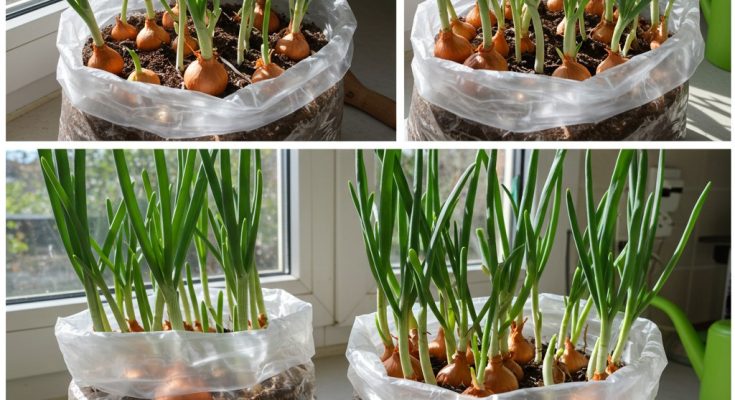In this guide, we will explore how to grow onions in plastic bags step by step, ensuring a high yield and year-round supply.
Why Grow Onions in Plastic Bags?
Using plastic bags to grow onions offers several advantages:
Space Efficiency – Ideal for balconies, patios, or even indoors.
Better Drainage Control – Prevents waterlogging and root rot.
Extended Growing Season – Allows for year-round cultivation.
Easy Mobility – Bags can be moved for optimal sunlight exposure.
Reduced Pest Issues – Elevating the plants minimizes exposure to soil pests.
Higher Yields – Maximizes available space for increased onion production.
Step-by-Step Guide to Growing Onions in Plastic Bags
Step 1: Choosing the Right Onion Variety
Different onion varieties thrive in different conditions. Select a variety that suits your climate and desired harvest time:
-
- Short-Day Onions – Best for warmer climates; examples include ‘Texas Sweet’ and ‘Granex’.
- Long-Day Onions – Best for cooler climates; examples include ‘Walla Walla’ and ‘Red Wethersfield’.
- Day-Neutral Onions – Can grow in most regions; examples include ‘Candy’ and ‘Superstar’.
- Green Onions (Scallions) – Fast-growing and ideal for continuous harvesting.
Step 2: Selecting the Plastic Bag and Preparing Drainage
-
- Choose heavy-duty plastic bags or reusable shopping bags.
- Ensure the bag is at least 12-15 inches deep for proper root development.
- Punch several small drainage holes at the bottom to prevent excess water buildup.
- If using grocery bags, double-layer them for extra durability.
Step 3: Preparing the Soil Mix
Onions thrive in light, well-draining soil rich in organic matter.
Ideal Soil Mix:
-
- 50% Garden Soil or Potting Mix – Provides essential nutrients.
- 30% Compost or Aged Manure – Improves fertility and moisture retention.
- 10% Sand or Perlite – Enhances drainage and prevents compaction.
- 10% Coco Peat or Peat Moss – Retains moisture while keeping the soil aerated.
Fill the plastic bag with soil, leaving 2-3 inches from the top to allow space for watering.
Step 4: Planting Onion Seeds or Sets
-
- If using seeds, sow them ¼ inch deep, spacing them ½ inch apart.
- If using onion sets (small onion bulbs), plant them 1-2 inches deep, spacing them 2-3 inches apart.
- Press the soil lightly and water gently to ensure good seed-to-soil contact.
Step 5: Optimal Growing Conditions
For best results, provide the following conditions:
-
- Sunlight – Onions require 6-8 hours of direct sunlight daily.
- Temperature – Ideal growing temperature is 55-75°F (13-24°C).
- Location – Place the plastic bag in a sunny spot like a balcony, terrace, or windowsill.
Caring for Your Onions in Plastic Bags
1. Watering
-
- Water consistently to keep the soil moist but not waterlogged.
- Check moisture levels by inserting a finger into the soil; water if the top 1-2 inches feel dry.
- Reduce watering once onions start forming bulbs to prevent rot.
2. Fertilizing
-
- Apply a balanced fertilizer (10-10-10) every 3-4 weeks.
- For organic growth, use compost tea, fish emulsion, or banana peel fertilizer.
- Avoid excessive nitrogen, as it encourages leaf growth over bulb formation.
3. Mulching
-
- Apply a thin layer of straw or dry leaves to retain moisture and suppress weeds.
- Mulching also helps regulate soil temperature.
4. Thinning the Seedlings
- Once seedlings reach 3-4 inches tall, thin them to 3 inches apart to prevent overcrowding.
- Use the removed seedlings as green onions in cooking.
5. Preventing Pests and Diseases
Although onions are relatively pest-resistant, watch out for common issues:
-
- Aphids & Thrips – Spray with neem oil or soapy water.
- Fungal Diseases – Avoid overhead watering and ensure good airflow.
- Onion Maggots – Keep the area clean and avoid overwatering.
Harvesting Onions for a Continuous Supply
For Green Onions (Scallions):
-
- Harvest when the leaves are 6-8 inches tall.
- Cut the greens 1 inch above the soil to allow regrowth.
- This method enables continuous harvesting without replanting.
For Bulb Onions:
-
- When the onion tops turn yellow and fall over, stop watering.
- Wait 1-2 weeks, then gently pull the onions from the soil.
- Cure them by laying them in a shady, dry area for 2-3 weeks before storage.
How to Grow Onions in Plastic Bags Year-Round
One of the biggest advantages of growing onions in plastic bags is the ability to harvest onions continuously throughout the year. Here’s how:
Successive Planting – Plant new onions every 2-4 weeks for a constant harvest.
Move Indoors During Winter – In cold climates, bring the bags indoors near a sunny window.
Use Grow Lights – If natural sunlight is limited, supplement with LED grow lights.
Regrow from Kitchen Scraps – Save onion roots and replant them in the bag for another cycle.
Store Bulbs Properly – Keep harvested onions in a cool, dry place to extend shelf life.
Conclusion
Growing onions in plastic bags is a simple, space-saving, and highly productive method for enjoying fresh onions all year round. By choosing the right variety, maintaining proper care, and ensuring successive planting, you can have a continuous supply of homegrown onions with minimal effort.
Whether you have a small balcony, a rooftop garden, or just a sunny windowsill, this method makes it easy for anyone to grow onions at home. Start planting today and enjoy the benefits of fresh, organic onions straight from your own mini garden!
